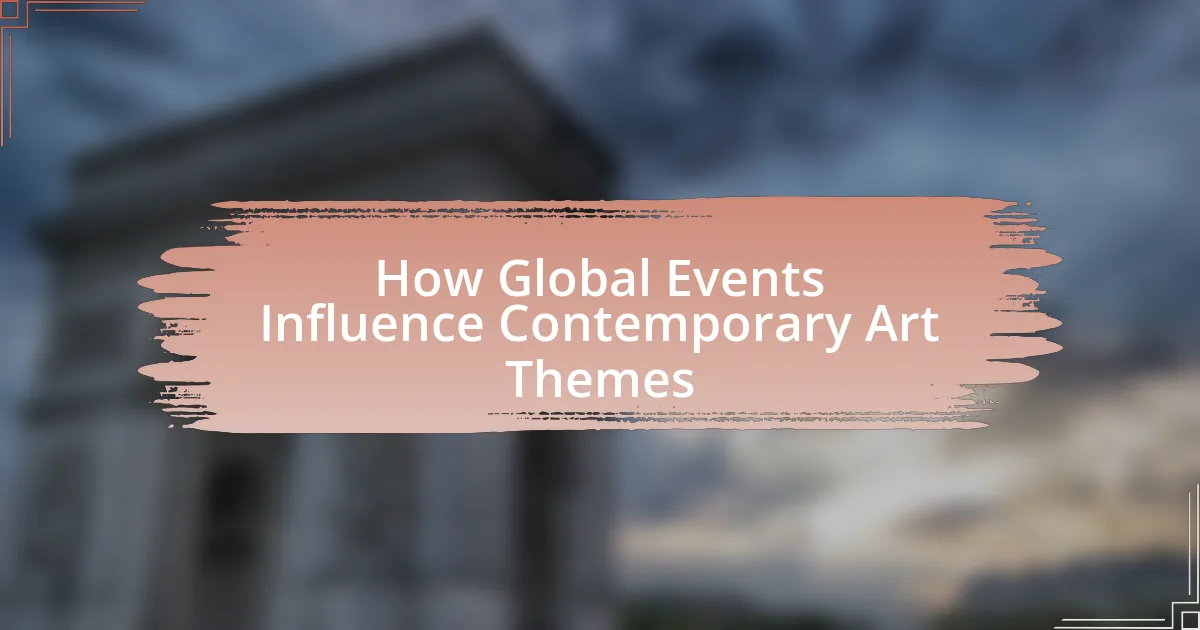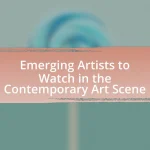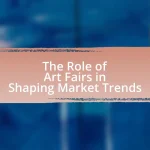The article examines how global events shape contemporary art themes, highlighting the influence of political upheavals, social movements, economic crises, technological advancements, and environmental changes on artistic expression. It discusses specific examples, such as the impact of the COVID-19 pandemic and the Black Lives Matter movement, which have prompted artists to explore themes of isolation, social justice, and community resilience. The article also emphasizes the importance of analyzing these influences to enhance appreciation of art as a reflection of societal values and challenges, while outlining practical steps artists can take to engage with global issues through collaboration and adaptive practices.
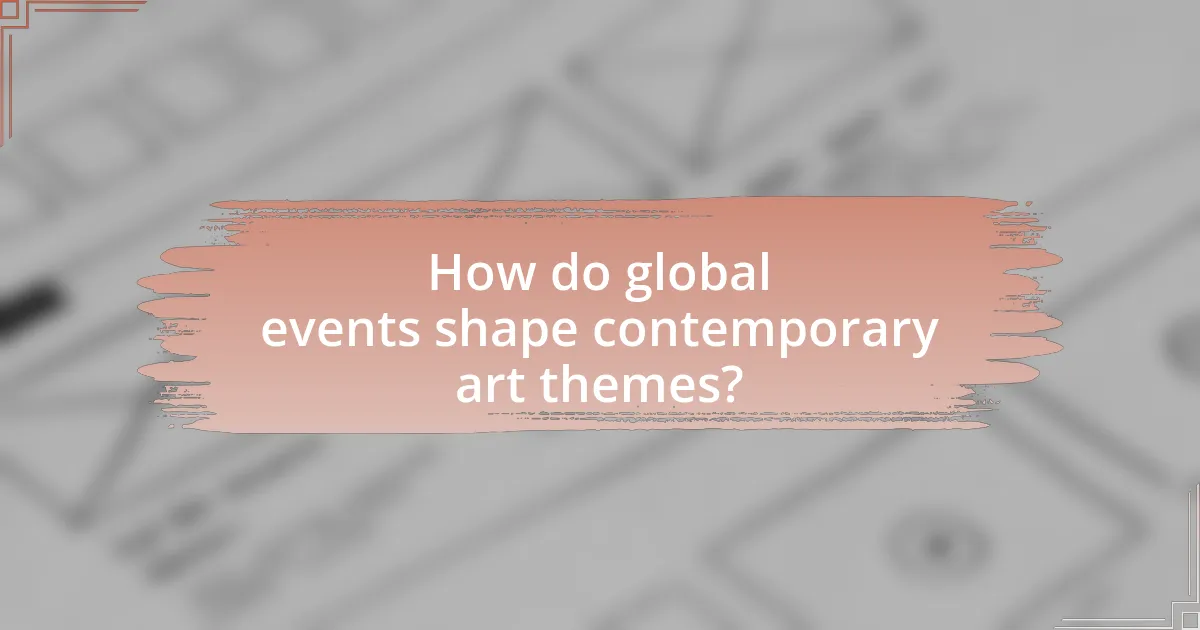
How do global events shape contemporary art themes?
Global events significantly shape contemporary art themes by influencing artists’ perspectives and the subjects they choose to explore. For instance, the COVID-19 pandemic prompted artists to address themes of isolation, health, and societal change, leading to a surge in works that reflect personal and collective experiences during lockdowns. Additionally, movements such as Black Lives Matter have inspired artists to engage with issues of racial injustice and social equity, resulting in powerful visual statements that resonate with current societal dialogues. These examples illustrate how contemporary art serves as a response to and reflection of pressing global issues, making it a vital medium for commentary and connection in today’s world.
What types of global events influence contemporary art?
Global events that influence contemporary art include political upheavals, social movements, economic crises, technological advancements, and environmental changes. Political upheavals, such as revolutions or regime changes, often inspire artists to respond to themes of freedom, oppression, and identity, as seen in the works emerging from the Arab Spring. Social movements, like Black Lives Matter, have prompted artists to address issues of race, justice, and equality, reflecting societal tensions and aspirations. Economic crises, such as the 2008 financial collapse, have led to art that critiques capitalism and explores themes of consumerism and sustainability. Technological advancements, including the rise of digital media, have transformed artistic practices and expanded the ways art is created and consumed. Environmental changes, particularly climate change, have spurred artists to engage with ecological themes, raising awareness about sustainability and the human impact on nature. Each of these global events shapes the narratives and aesthetics of contemporary art, making it a reflection of the times.
How do political events impact artistic expression?
Political events significantly impact artistic expression by shaping the themes, styles, and mediums artists choose to convey their messages. For instance, during periods of political upheaval, such as the Civil Rights Movement in the United States, artists like Jacob Lawrence used their work to reflect social injustices and advocate for change, thereby influencing public perception and dialogue. Additionally, political censorship can lead to the emergence of underground art movements, as seen in countries with authoritarian regimes, where artists create subversive works to critique the government. This relationship between politics and art demonstrates how external circumstances can drive creativity and innovation in artistic expression.
What role do social movements play in contemporary art themes?
Social movements significantly influence contemporary art themes by serving as catalysts for social change and reflection. Artists often draw inspiration from movements such as Black Lives Matter, Me Too, and climate activism, using their work to address issues of inequality, justice, and environmental concerns. For instance, the rise of street art and protest art has been closely linked to social movements, with artists like Banksy and Ai Weiwei creating pieces that critique political systems and advocate for human rights. This intersection of art and activism not only raises awareness but also fosters dialogue, making art a powerful medium for social commentary and engagement.
Why is it important to analyze the influence of global events on art?
Analyzing the influence of global events on art is important because it reveals how societal changes, political movements, and cultural shifts shape artistic expression. For instance, the impact of World War II on art movements like Abstract Expressionism illustrates how artists responded to trauma and chaos, reflecting broader human experiences. Additionally, events such as the Civil Rights Movement in the United States led to the emergence of art that challenged social norms and advocated for change, demonstrating art’s role as a vehicle for social commentary. Understanding these connections enhances our appreciation of art as a reflection of historical context and human emotion.
How does understanding this influence enhance our appreciation of art?
Understanding the influence of global events enhances our appreciation of art by providing context that deepens our emotional and intellectual engagement with the work. For instance, recognizing that a piece of art was created in response to a significant historical event, such as the Vietnam War or the COVID-19 pandemic, allows viewers to grasp the artist’s motivations and the societal commentary embedded in the artwork. This contextual knowledge can transform a passive viewing experience into an active dialogue, where the audience reflects on the implications of the art in relation to the events that inspired it. Studies have shown that art that resonates with contemporary issues often evokes stronger emotional responses, as it connects personal experiences with broader societal narratives, thereby enriching the overall appreciation of the art.
What insights can we gain about society through contemporary art?
Contemporary art provides insights into societal values, beliefs, and issues by reflecting the cultural, political, and social contexts of its time. For instance, artworks created in response to global events, such as the COVID-19 pandemic, often explore themes of isolation, health, and community resilience, illustrating how artists interpret and critique societal challenges. Additionally, movements like Black Lives Matter have inspired artists to address systemic racism and social justice, showcasing the role of art in activism and public discourse. These examples demonstrate that contemporary art serves as a mirror to society, revealing underlying tensions and aspirations while fostering dialogue about pressing issues.
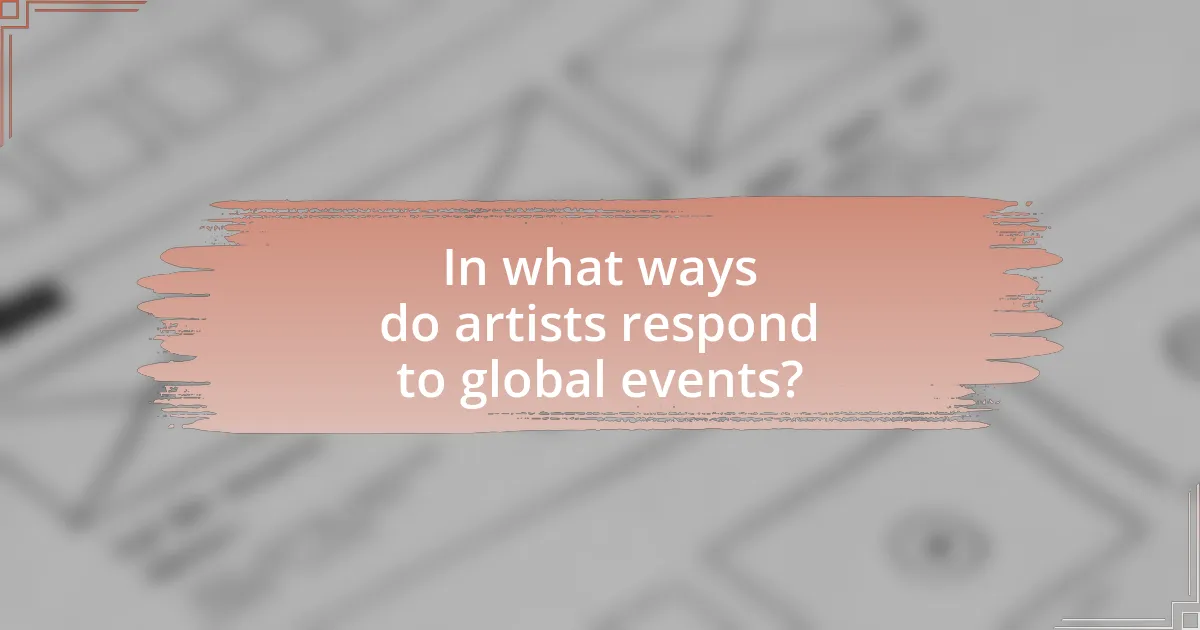
In what ways do artists respond to global events?
Artists respond to global events through various mediums, including visual art, music, literature, and performance, often reflecting societal issues, emotions, and cultural shifts. For instance, during the COVID-19 pandemic, many artists created works that addressed themes of isolation, resilience, and community, such as the “Art for the Frontline” initiative, which showcased art to support healthcare workers. Additionally, artists often engage in activism, using their platforms to raise awareness about issues like climate change, social justice, and political unrest, as seen in the works of artists like Ai Weiwei, who critiques government policies and human rights violations. These responses not only document historical moments but also provoke dialogue and inspire change within society.
How do artists incorporate current events into their work?
Artists incorporate current events into their work by responding to social, political, and environmental issues through various mediums. For instance, many contemporary artists create pieces that reflect the impact of events such as climate change, social justice movements, or political unrest. A notable example is the work of Ai Weiwei, who addresses human rights and freedom of expression in response to governmental actions in China. Additionally, artists often utilize social media platforms to disseminate their work and engage with audiences on pressing issues, thereby amplifying their messages. This practice not only raises awareness but also fosters dialogue around significant global events, demonstrating the powerful role of art in societal discourse.
What techniques do artists use to convey messages about global issues?
Artists use various techniques to convey messages about global issues, including symbolism, visual metaphors, and multimedia installations. Symbolism allows artists to represent complex ideas through recognizable images, such as using a dove to symbolize peace or a skull to represent mortality. Visual metaphors create connections between disparate concepts, enabling viewers to understand the implications of global issues, like climate change depicted through melting icebergs. Multimedia installations combine different forms of media, such as video, sound, and sculpture, to create immersive experiences that engage audiences emotionally and intellectually, exemplified by works addressing refugee crises or environmental degradation. These techniques effectively communicate urgent global concerns, fostering awareness and prompting dialogue among viewers.
How does the medium of art affect the representation of global events?
The medium of art significantly affects the representation of global events by shaping how messages are conveyed and perceived. Different mediums, such as painting, sculpture, photography, and digital art, each have unique characteristics that influence the emotional and intellectual engagement of the audience. For instance, photography can capture real-time events with immediacy, as seen in photojournalism during conflicts, which provides a stark, unfiltered view of reality. In contrast, painting allows for abstraction and interpretation, enabling artists to express personal or cultural narratives surrounding global events, such as Pablo Picasso’s “Guernica,” which powerfully depicts the horrors of war. Thus, the choice of medium not only determines the aesthetic quality of the representation but also influences the depth of understanding and emotional impact on the audience.
What are some notable examples of art influenced by global events?
Notable examples of art influenced by global events include Pablo Picasso’s “Guernica,” which responds to the bombing of Guernica during the Spanish Civil War, and Ai Weiwei’s “Sunflower Seeds,” which critiques China’s cultural and political landscape. “Guernica,” created in 1937, serves as a powerful anti-war statement, reflecting the horrors of conflict and the impact on civilians. Ai Weiwei’s installation, made from millions of handcrafted porcelain seeds, symbolizes the loss of individuality in a mass society and comments on issues of freedom and human rights in China. These artworks exemplify how artists respond to and reflect significant historical and political events through their creative expressions.
Which contemporary artists have addressed significant global issues?
Contemporary artists who have addressed significant global issues include Ai Weiwei, Banksy, and Olafur Eliasson. Ai Weiwei has focused on human rights and freedom of expression, notably through his installation “Sunflower Seeds,” which critiques mass production and individualism. Banksy often tackles themes of war, consumerism, and social justice, as seen in his mural “Girl with a Balloon,” which symbolizes hope amidst despair. Olafur Eliasson addresses climate change and environmental issues, exemplified by his work “The Weather Project,” which raises awareness about the impact of human activity on nature. These artists utilize their platforms to provoke thought and inspire action regarding pressing global challenges.
How have specific artworks reflected societal changes due to global events?
Specific artworks have reflected societal changes due to global events by addressing themes of conflict, identity, and resilience. For instance, Pablo Picasso’s “Guernica” directly responds to the bombing of the Basque town during the Spanish Civil War, illustrating the horrors of war and its impact on civilians. Similarly, Ai Weiwei’s “Sunflower Seeds” critiques the mass production and loss of individuality in contemporary society, influenced by China’s Cultural Revolution and its aftermath. These artworks serve as visual commentaries that encapsulate the emotional and social upheavals resulting from global events, thereby fostering public discourse and awareness.

What are the implications of global events on the future of contemporary art?
Global events significantly shape the future of contemporary art by influencing themes, mediums, and the socio-political context in which art is created and consumed. For instance, the COVID-19 pandemic prompted artists to explore isolation, community, and digital engagement, leading to a surge in virtual exhibitions and online art sales. Additionally, movements such as Black Lives Matter have inspired artists to address issues of racial injustice and inequality, resulting in a more politically charged art landscape. Historical examples include the impact of World War II on surrealism and the Cold War on abstract expressionism, demonstrating how global crises can redefine artistic expression and priorities. Thus, the implications of global events are profound, driving artists to respond to contemporary issues and reshaping the art world’s trajectory.
How might future global events shape emerging art trends?
Future global events will significantly shape emerging art trends by influencing the themes, mediums, and messages artists choose to explore. For instance, the COVID-19 pandemic has already led to a rise in digital art and virtual exhibitions, as artists adapted to social distancing measures and sought new ways to engage audiences. Additionally, global movements such as climate change activism and social justice protests have prompted artists to address these urgent issues in their work, reflecting societal concerns and fostering dialogue. Historical examples, such as the impact of World War II on surrealism and the rise of political art during the civil rights movement, demonstrate how global events can catalyze shifts in artistic expression and priorities.
What potential themes could arise from ongoing global challenges?
Ongoing global challenges could give rise to themes such as resilience, social justice, environmental sustainability, and the impact of technology on society. Resilience is often depicted in art as a response to crises, reflecting human strength and adaptability in the face of adversity. Social justice themes emerge from movements addressing inequality and discrimination, as seen in works inspired by protests and advocacy for marginalized communities. Environmental sustainability is increasingly represented in contemporary art, highlighting climate change and ecological concerns, as artists respond to the urgent need for awareness and action. The impact of technology on society is another theme, exploring how digital advancements affect human relationships and cultural expression, often critiquing the implications of a hyper-connected world. These themes are validated by the increasing prevalence of related artworks in exhibitions and public discourse, demonstrating the direct influence of global events on contemporary artistic expression.
How can artists prepare for and respond to future global events?
Artists can prepare for and respond to future global events by developing adaptive practices and engaging with their communities. By staying informed about global issues and trends, artists can create relevant work that resonates with societal concerns. For instance, during the COVID-19 pandemic, many artists utilized digital platforms to reach audiences, showcasing how adaptability can maintain artistic relevance. Additionally, artists can collaborate with organizations focused on social justice, climate change, or public health, allowing their work to contribute to broader dialogues. Historical examples, such as the response of artists during the AIDS crisis in the 1980s, demonstrate how art can serve as a powerful tool for advocacy and awareness in times of crisis.
What practical steps can artists take to engage with global issues?
Artists can engage with global issues by creating works that reflect social, political, and environmental themes. This can involve using their art to raise awareness about pressing matters such as climate change, human rights, and social justice. For instance, artists can participate in collaborative projects that address these issues, such as community murals or installations that provoke dialogue. Additionally, they can leverage social media platforms to share their messages and connect with a broader audience, amplifying their impact. Research indicates that art can effectively influence public perception and inspire action, as seen in campaigns like “Art for Change,” which mobilizes artists to address global challenges through creative expression.
How can collaboration among artists enhance responses to global events?
Collaboration among artists enhances responses to global events by combining diverse perspectives and skills, leading to more impactful and nuanced artistic expressions. When artists from various backgrounds work together, they can address complex issues such as climate change, social justice, or political unrest more effectively than individuals working in isolation. For instance, the “Artists for Peace” initiative, which brought together artists from different disciplines to create works addressing global conflicts, demonstrated how collaborative efforts can amplify messages and reach wider audiences. This collective approach not only fosters innovation but also encourages dialogue and engagement, making the art more relevant and resonant in the context of pressing global challenges.
What resources are available for artists to explore global themes in their work?
Artists can explore global themes in their work through various resources such as international art residencies, online platforms, and collaborative projects. International art residencies, like those offered by the Banff Centre for Arts and Creativity, provide artists with the opportunity to engage with diverse cultures and perspectives, fostering a deeper understanding of global issues. Online platforms, such as Artsy and Saatchi Art, allow artists to connect with a global audience and access a wide range of artworks that address contemporary themes. Collaborative projects, like the Global Art Project, encourage artists to work together across borders, sharing insights and experiences that reflect global narratives. These resources collectively enhance artists’ ability to engage with and represent global themes in their work.
